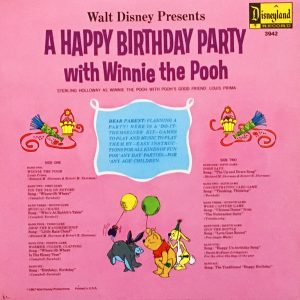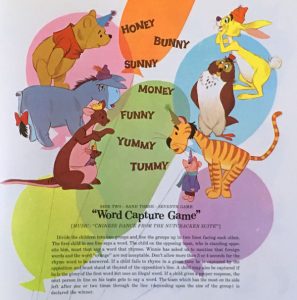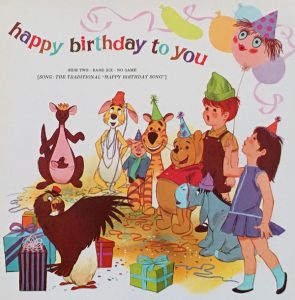In which we note that Sterling Holloway would be 115 this Saturday and look at a Grammy-nominated grab-bag of eclectic music, strange casting and a few Mouseketeers.

Walt Disney Presents
A HAPPY BIRTHDAY PARTY WITH WINNIE THE POOH
Disneyland Records – Storyteller Series ST-3942 (12” 33 1/3 RPM with Book / Mono)
Released in June 1966. Executive Producer / Writer: Jimmy Johnson. Producer / Musical Director: Tutti Camarata. Running Time: 27 minutes.
Voices: Sterling Holloway (Pooh); Louis Prima (Himself); Junius Matthews (Owl); Robie Lester (Christopher Robin, Rabbit).
Vocalists: Gia Maione, Carol Lombard, Ron Hicklin, Al Capps; Camarata Chorus; the Mickey Mouse Club Mouseketeers (including Jimmie Dodd, Darlene Gillespie; Sharon Baird and Tommy Cole).
Songs: “Winnie the Pooh,” “Little Black Rain Cloud,” “Up, Down and Touch the Ground” from Winnie the Pooh and the Honey Tree) by Richard M. Sherman, Robert B. Sherman; “Where Oh Where Is Eeyore’s Tail?,” “Who’s At Rabbit’s Table?” “Can You Find the Honey Tree?” “Birthday, Birthday” by Tom Campbell, Mark Turnbull; “Love Goes Round On a Merry-Go-Round” by Leo Fox, Tim Gayle, Clem Watts (Albert J. Trace).
Archival Tracks: “The Unbirthday Song” (from the Disneyland album, Alice in Wonderland: Music from the Score) by Al Hoffman, Mack David, Jerry Livingston; “Chinese Dance” (from The Nutcracker Suite sequence in Fantasia) by Piotr Ilych Tchaikovsky; “Happy Birthday” (from the Mickey Mouse Club album, Holidays with the Mouseketeers) (Public Domain).
Instrumental: “Thinking, Thinking” by Mark Turnbull.
 Sterling Holloway was one of those voice actors so skillful that he need only change his attitude and inflections to create entirely new characters. While the Cheshire Cat, Kaa the python, Mister Stork in Dumbo, Roquefort in The Aristocats and Winnie the Pooh all had the same basic timbre, it was the acting that made all the difference.
Sterling Holloway was one of those voice actors so skillful that he need only change his attitude and inflections to create entirely new characters. While the Cheshire Cat, Kaa the python, Mister Stork in Dumbo, Roquefort in The Aristocats and Winnie the Pooh all had the same basic timbre, it was the acting that made all the difference.
Holloway studied at the American Academy of Dramatic Arts in New York in his teens and made a huge splash on Broadway when he introduced the song “(I’ll Take) Manhattan” in the Rodger and Hart musical, Garrick’s Gaieties. Frank Capra gave him his first big break in movies, with 1932’s American Madness. When Walt Disney was planning Snow White and the Seven Dwarfs, he suggested Holloway as a model for Sleepy.
His many character role credits in films include “Willie,” Beulah Bondi’s farmhand in the beloved holiday classic Remember the Night (1940) with Barbara Stanwyck and Fred MacMurray. His melodic singing voice can be heard in this memorable scene:
Holloway could do wonders with words and his skilled narrations elevated countless radio shows, cartoons and recordings. Disneyland Records signed Holloway to a contract in 1957. He even wrote some of them, including the Country Cousin album discussed in this Spin.
Walt Disney’s 1966 short film version of Winnie the Pooh and the Honey Tree had only been in theaters for a few months when the Happy Birthday Party with Winnie the Pooh album was released, but it was certainly not alone in the variety of shiny new books, toys and cereal box premiums.
 However, both the casting and scope of Pooh in Disney’s realm were still very early in development. Even Walt was not completely sure how the American audiences would take to the gentle charms of A.A. Milne’s creations, or if they could carry a full-length feature. The Honey Tree featurette was a test run of sorts, with two more films to follow that would be combined with bridging footage to make 1977’s The Many Adventures of Winnie the Pooh.
However, both the casting and scope of Pooh in Disney’s realm were still very early in development. Even Walt was not completely sure how the American audiences would take to the gentle charms of A.A. Milne’s creations, or if they could carry a full-length feature. The Honey Tree featurette was a test run of sorts, with two more films to follow that would be combined with bridging footage to make 1977’s The Many Adventures of Winnie the Pooh.
Disneyland Records released two LPs (see this Spin) and several singles based Winnie the Pooh and the Honey Tree eight months before the featurette was in theaters (a common practice in those days with books and records especially, to create momentum). The response must have been so great, even before the film, that the label set to work on new products.
In some ways, A Happy Birthday Party with Winnie the Pooh is ingenious and meticulously executed. In other small ways, the short time frame is evident. Every children’s record company released birthday albums with party suggestions, but none organized the format as well or had the powerhouse of Pooh characters to make it irresistible.
Colorful and child-friendly as the packaging is, the facts of the children’s record business are that the parents/caregivers are really the ones who are being primarily addressed with the covers and the liner notes. On this album, it is made very clear from the outset—it’s practically a birthday party in a package, according to the notes (likely written by Jimmy Johnson, who was also the president of Disneyland Records). Just add cake. The track listings are carefully spelled out as “band one, band two,” and so on, the way Disney’s more grown-up releases used the terms, such as Mary Poppins and Chilling, Thrilling Sounds of the Haunted House.
 The 11-page book has lots of nice illustrations but the text is also filled with instructions for a number of games. These are quite helpful for anyone planning a party or event for kids because you don’t have to be celebrating a birthday party to play all the games. The songs all correspond to the pages and activities in the book, much like educational products made for schools.
The 11-page book has lots of nice illustrations but the text is also filled with instructions for a number of games. These are quite helpful for anyone planning a party or event for kids because you don’t have to be celebrating a birthday party to play all the games. The songs all correspond to the pages and activities in the book, much like educational products made for schools.
It is in this text and on the song listings that nits can be picked. Several songs are named incorrectly, but not so much that they are impossible to identify (“Where Oh Where is the Honey Tree?” should be “Can You Find the Honey Tree?” etc.) A reason for this is that printed materials have to be sent off earlier because they can take longer to complete than the recording. These little mistakes are probably due to a need for speed in getting the album into stores by summer.
Musically, vocally and technically the recording is top-notch. The reduced budgets of the much leaner years in the mid-‘60s are reflected in simple folk arrangements for the original songs, but Camarata was savvy enough to make it work. The songs are done in a Peter, Paul and Mary folk style, very much in vogue after their hit, “Puff, the Magic Dragon.” Tom Campbell, who wrote the Disney LP The Further Adventures of Jiminy Cricket (see this Spin), teamed with his colleague, musician/storyteller Mark Turnbull for four new songs (and one instrumental by Turnbull called “Thinking, Thinking.”)
Three of Hollywood’s best session singers performed them in a warm, genial style: Al Capps singing bass, who is responsible for countless major film and recording projects; Carol Lombard (no relation to Gable’s Carole), who sang on Annette’s records and had a children’s chorus that recorded the theme to the classic Japanese animated series Prince Planet, and Ron Hicklin, whose singing group was heard in almost every TV show and movie of the late ‘60s and ‘70s including Love, American Style, Happy Days, Pufnstuf, The Partridge Family and the movie version of M*A*S*H.
The entire album is “hosted” by Louis Prima, before he became known as the voice of King Louie. A friend of Tutti Camarata, he recorded “Winnie the Pooh” as a single with his wife, Gia Maione. They had already done an album of Mary Poppins songs together. Camarata’s role in bringing this talent into the Walt Disney Studios and how it connected to films and theme park attractions is highly significant. When the Primas’ young daughter was visiting the studio, Johnson gave her a copy of the Songs from Winnie the Pooh and the Honey Tree album and she noticed that Tigger was on the back cover, yet Tigger was not in the first Pooh film!
 Pooh’s history with Disney was so early, Tigger had not been fully developed. Tigger appears throughout the Happy Birthday Party book illustrations, but he more resembles the Ernest E. Sheperd version, not the Disney character seen two years later in 1968’s Winnie the Pooh and the Blustery Day. Even the script doesn’t get Pooh’s name quite right. He is rarely, if ever, called “Winnie,” yet on this record he is referred to in that way by Prima, Owl and even Pooh in the third person!
Pooh’s history with Disney was so early, Tigger had not been fully developed. Tigger appears throughout the Happy Birthday Party book illustrations, but he more resembles the Ernest E. Sheperd version, not the Disney character seen two years later in 1968’s Winnie the Pooh and the Blustery Day. Even the script doesn’t get Pooh’s name quite right. He is rarely, if ever, called “Winnie,” yet on this record he is referred to in that way by Prima, Owl and even Pooh in the third person!
The voice casting on the album also reflects the time crunch and the infancy of Disney’s version of Pooh. Sterling Holloway plays Pooh, of course. But Junius Matthews–the original film voice of Rabbit–voices Owl on the record presumably because he sounds British and dignified and also because Owl serves as a “co-host” with quite a few lines. Rabbit is voiced by Robie Lester, who also plays Roo and Christopher Robin, each of whom has only a few lines each. The person voicing Eeyore sounds like a staff member brought in because he has a sullen demeanor. (The voice session was probably so fast, there was no provision made for the fact that Owl very obviously was supposed to be introducing the song “Mind Over Matter” before it was discovered that the lyrics wouldn’t fit the game and the “Thinking” song plays instead.)
The odd voice casting might have been more of an issue had this album told an actual story, but this is essentially a song album with commentary. Three tracks are borrowed from other albums: the “Chinese Dance” from Fantasia, “The Unbirthday Song” from The Greatest Album Ever Made; and the “Happy Birthday” song itself from a Mickey Mouse Club record released in 1958 (see this Spin).
Nevertheless, these are the kind of bobbles you only find very deep in the hundred-acre wood. Though never reissued on CD or download, the album had a strong run in its day and the songs were carried over into other Pooh compilations throughout the vinyl era.
“Love Goes ’Round On a Merry-Go-Round” – Ron Hicklin, Carol Lombard and Al Capps
Camarata dug into the “old song” files to find this obscure pop tune, written in 1950 when the Walt Disney Music Company was venturing into the pop music business (totally outside of films) for the first time. Several top-charting hits, including “Shrimp Boats,” No Other Love” and “Mule Train” were commissioned by top songwriters strictly for records, sheet music and public performance. “Love Goes ’Round” was one of these songs, and though it was published whatever recordings were made have yet to cross the Spin turntable. One of the songwriters (writing under the name Clem Watts) was ’30s bandleader Al Trace, who specialized in novelty groups—one of which was called the “Silly Symphonists” with no apparent Disney connection.


 GREG EHRBAR is a freelance writer/producer for television, advertising, books, theme parks and stage. Greg has worked on content for such studios as Disney, Warner and Universal, with some of Hollywood’s biggest stars. His numerous books include Mouse Tracks: The Story of Walt Disney Records (with Tim Hollis). Visit
GREG EHRBAR is a freelance writer/producer for television, advertising, books, theme parks and stage. Greg has worked on content for such studios as Disney, Warner and Universal, with some of Hollywood’s biggest stars. His numerous books include Mouse Tracks: The Story of Walt Disney Records (with Tim Hollis). Visit 






















































A good old Georgia boy!
I didn’t realize the connection with Louis Prima.
Here he is singing “Winnie the Pooh”:
https://www.youtube.com/watch?v=V5JjEI4TU2I
Dunno how feasible it is, but someone should do an in-depth profile of Sterling Holloway. Once-in-a-lifetime voice and nuanced acting chops.
As a kid in the 50s, I had a Disney phonograph of Peter and the Wolf, and I was mesmerized by SH’s narration. I came to associate him with Disney in general; no other cartoon studio had “that guy” (as far as I knew).
Pretty sure he was featured on an episode of Twilight Zone as well. Great character actor’s face to go along with the voice.
Yes, he was in the fifth season episode, “What’s in the Box”. His reaction at Rod Serling’s closing thought is a classic!!! Well worth watching it!!!
This happens to be very timely for me, because New Year’s Day is my birthday!!!
As a child, I savored this Winnie-the-Pooh record as much as the others that were coming out about the same time. The version of Tigger that appears here is similar to his appearance in the original booklet illustrations for the “Blustery Day” album.
There was an over-sized Pooh birthday book which also was in the stores during this era. The book used the Ernest Sheppard illustrations instead of the Disney versions, and the games seemed to be more consistent with the types of games played by the characters in the original book. The Pooh Birthday Book and Pooh Birthday Album were clearly not intended to work in tandem, and yet when I combined both of these for my New Year’s Day birthday party one year, it seemed to work pretty well. Without really meaning to, the two Pooh party approaches sort of blended together–and this way both versions of the characters were much in evidence.
I think the thing I have liked most about this album is the relaxed tone, and the relative absence of any real conflict. Characters have come together not to solve a problem or help one another out of difficulty, but simply to enjoy a fun party. One lyric in the “Birthday Birthday” song that my friends and I could never figure out was a line that sounds like “soda pop parade” but the next line rhymes it with “Join us in a little birthday game”, so I’m wondering if the lyrics were different from what my friends and I thought. Or maybe the singers didn’t pronounce it clearly enough?
The pauses in “Who’s at Rabbit’s Table” are a little annoying when listened to, and they aren’t long enough for completing a round of musical chairs, so maybe the producers should have just let the song play normally and let the home listeners stop the song by lifting the needle, which they had to do in any case. Besides, there isn’t likely to be a game of musical chairs going on every time the record is played.
I loved the presence of Louis Prima on this album. By the time I heard this, I already knew him as the voice of King Louie, and his “scat” version of the Pooh song is really delightful. It’s as though King Louie and Winnie the Pooh were jointly hosting the party, which in a sense they were. I also liked the finale “Happy Birthday” song by the Mousketeers, who were still in recent memory when the album was current.
Thanks for this information. I appreciate knowing more about the production of this album–a much-loved childhood experience.
Many thanks to you, Frederick. Knowing how this album enriched your life adds such meaning and importance to it. So many of the records we talk about in Spin are shining works of creative, historic and human importance, and I always appreciate your comments that help elaborate on that.
Can’t help but notice the strong (presumably unintentional) resemblance between “Love Goes Round on a Merry Go Round” and “The Merry Go Round Broke Down”.